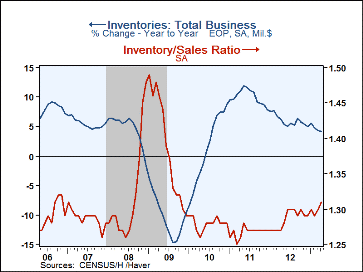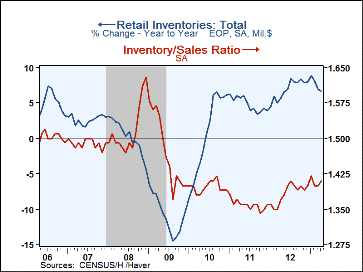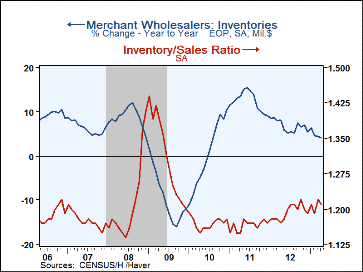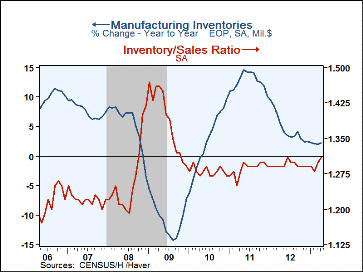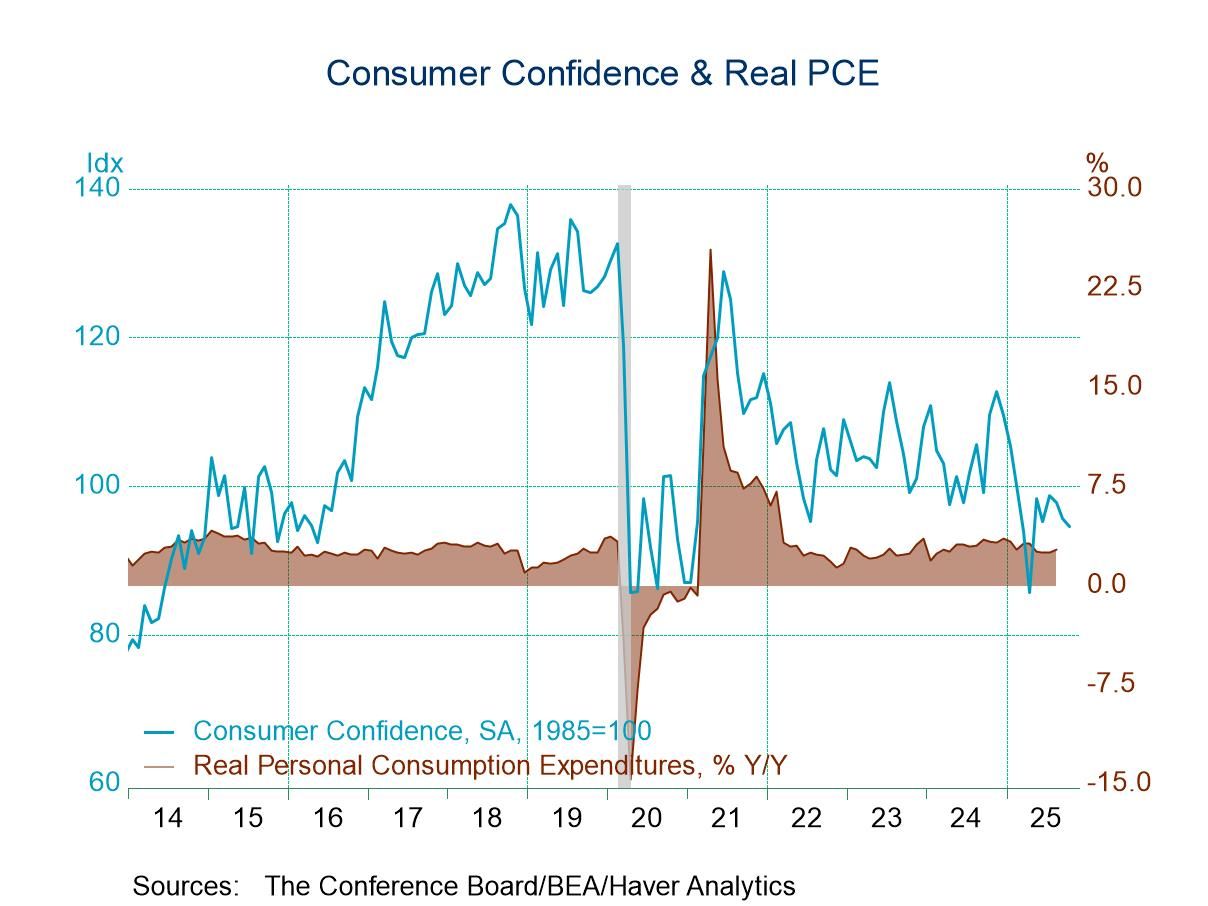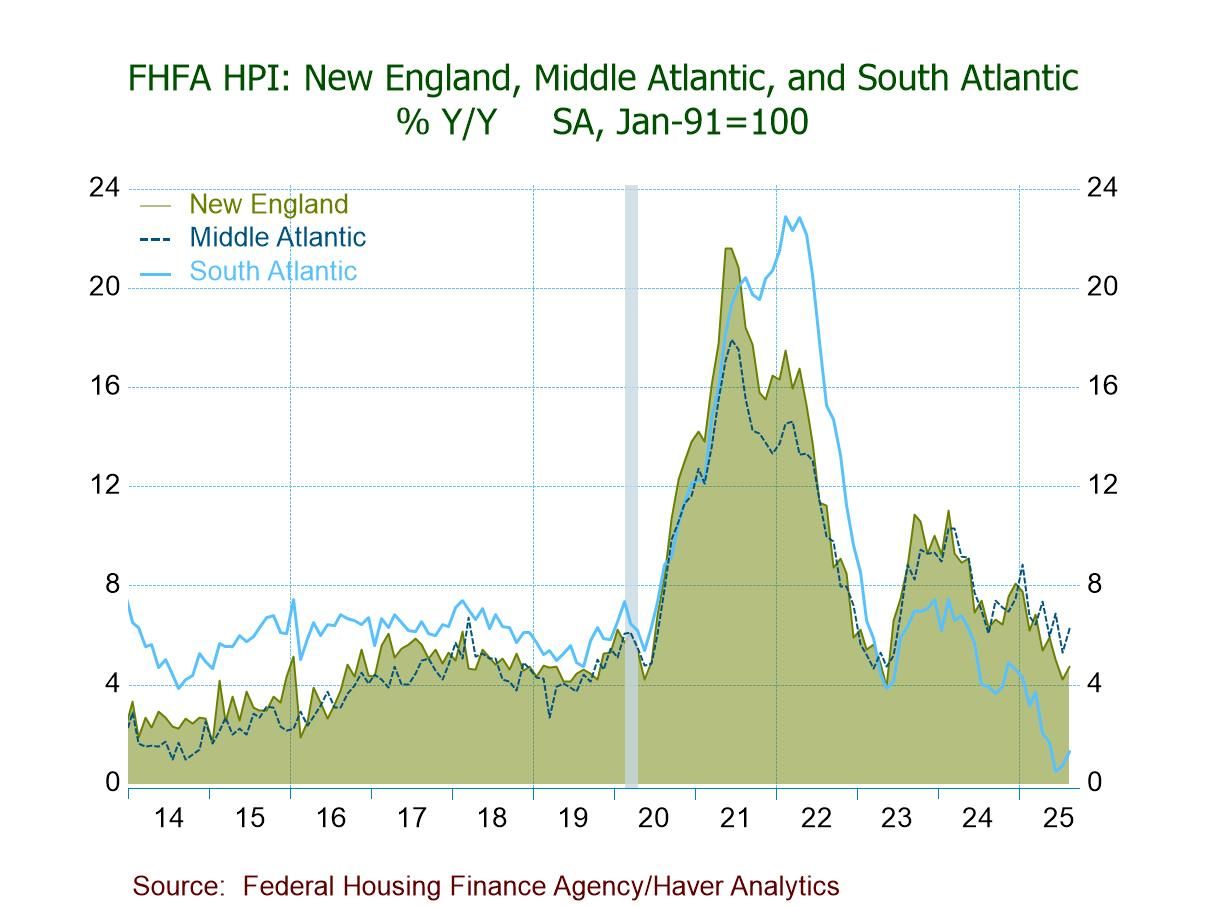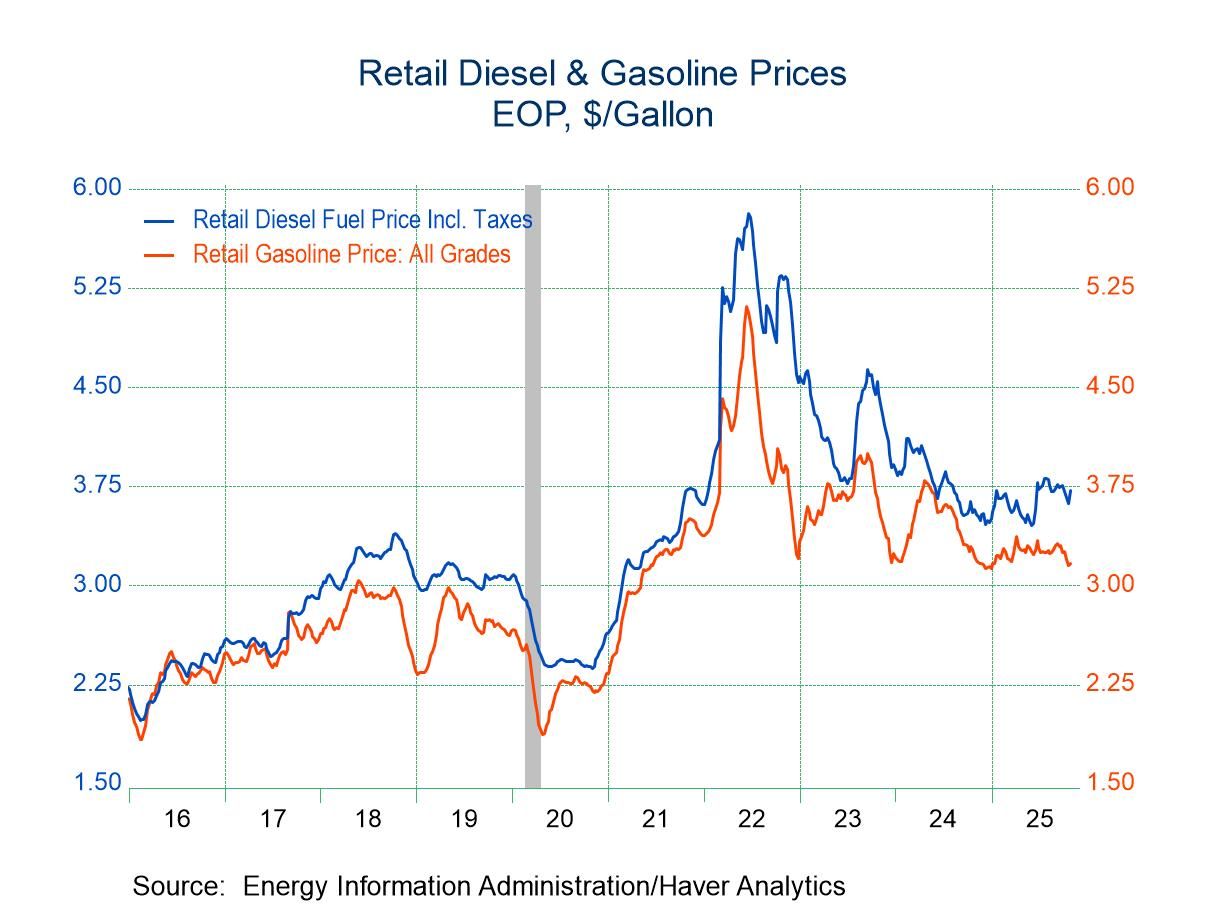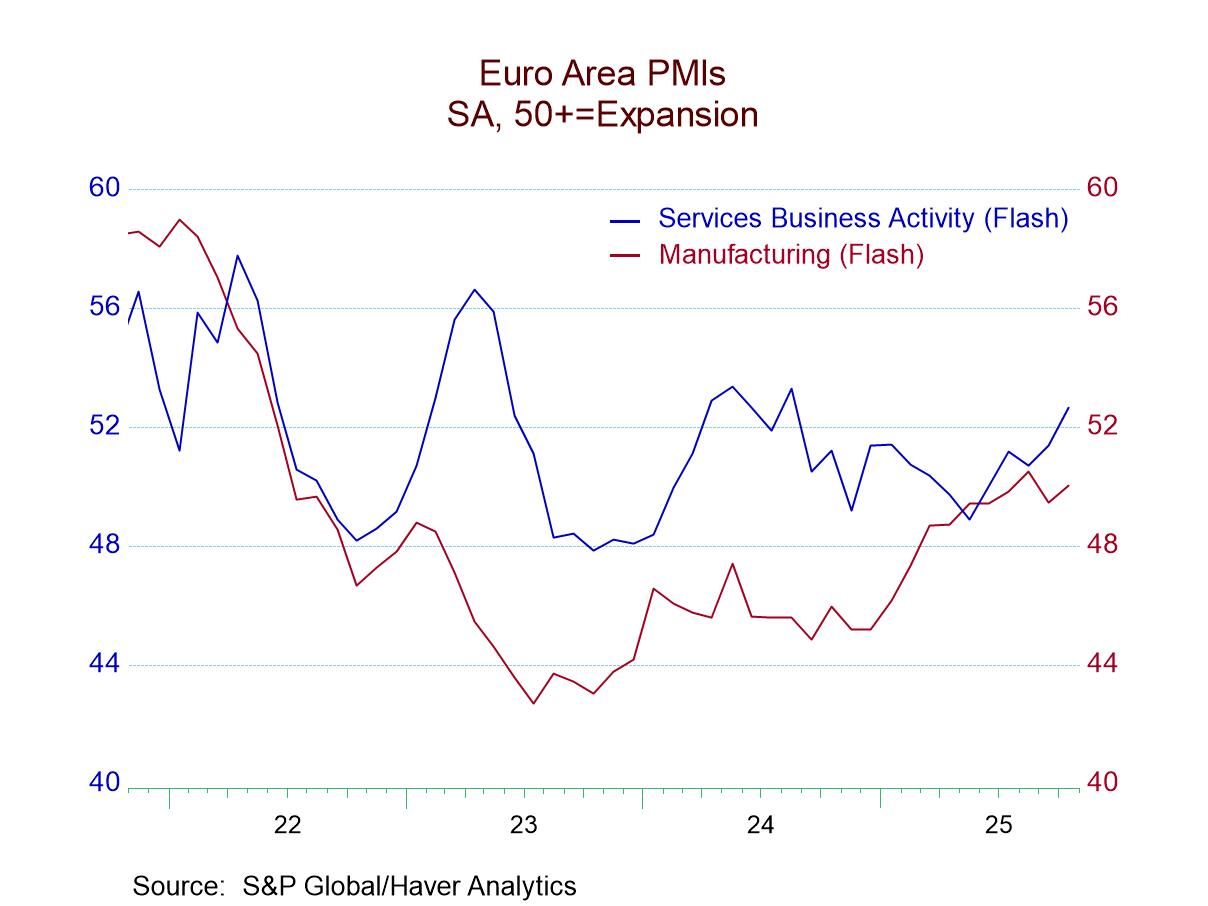 Global| Jun 13 2013
Global| Jun 13 2013U.S. Business Inventories Post Increase Moderately
by:Tom Moeller
|in:Economy in Brief
Summary
Total business inventories gained 0.3% (4.2% y/y) after having been roughly unchanged for two months. The figure was accompanied by a 0.1% slip (+1.5% y/y) in business sales, the second month of decline. As a result, the inventory-to- [...]
Total business inventories gained 0.3% (4.2% y/y) after having been roughly unchanged for two months. The figure was accompanied by a 0.1% slip (+1.5% y/y) in business sales, the second month of decline. As a result, the inventory-to-sales ratio ticked up to 1.31, its highest level since October 2009.
In the retail sector, inventories rose 0.4% (6.6% y/y) led by a 0.5% rise (13.1% y/y) in motor vehicles. Inventories excluding autos rose 0.4% (3.9% y/y). The increase was led by a 1.1% rise (5.6% y/y) in apparel inventories. General merchandise inventories rose 0.4% (5.0% y/y). Building material stores raised inventories 3.8% y/y while inventories at food & beverage stores rose 1.9% y/y. Furniture and appliance store inventories fell 0.6% (-1.4% y/y). The retail inventory-to-sales ratio of 1.41 remained its highest since September 2009.
Merchant wholesale inventories gained 0.2% (4.1% y/y). The y/y gain, however, was less than half that of the prior two years. The restraint continues in both durable and nondurable good industries. The inventory-to-sales ratio has been trending higher. Factory sector inventories rose 0.2% (2.3% y/y). The inventory-to-sales ratio rose to 1.31, its highest since October 2009.
Business sales slipped 0.1% (+1.5% y/y). Wholesale sales gained 0.5% (0.7% y/y). Factory shipments also were down by 0.7% (+0.6% y/y). As reported earlier, retail sales rose 0.7% (3.5% y/y). Sales excluding autos slipped 0.1% (+2.6% y/y).
The manufacturing and trade data are in Haver's USECON database.
| Business Inventories(%) | Apr | Mar | Feb | Apr Y/Y | 2012 | 2011 | 2010 |
|---|---|---|---|---|---|---|---|
| Total | 0.3 | -0.1 | 0.0 | 4.2 | 5.1 | 7.9 | 8.8 |
| Retail | 0.4 | -0.6 | 0.2 | 6.6 | 8.0 | 3.9 | 6.2 |
| Retail excl. Motor Vehicles | 0.4 | -0.7 | 0.4 | 3.9 | 3.5 | 3.6 | 3.9 |
| Merchant Wholesalers | 0.2 | 0.3 | -0.4 | 4.1 | 5.5 | 9.2 | 10.5 |
| Manufacturing | 0.2 | 0.0 | 0.2 | 2.3 | 2.4 | 10.2 | 9.8 |
| Business Sales (%) | |||||||
| Total | -0.1 | -1.2 | 1.3 | 1.5 | 4.4 | 11.0 | 9.7 |
| Retail | 0.7 | 0.0 | -0.4 | 3.5 | 5.1 | 7.7 | 5.8 |
| Retail excl. Motor Vehicles | -0.1 | -0.4 | 1.2 | 2.6 | 4.4 | 7.1 | 4.6 |
| Merchant Wholesalers | 0.5 | -1.4 | 1.3 | 0.7 | 4.3 | 12.8 | 12.1 |
| Manufacturing | -0.7 | -1.5 | 1.3 | 0.6 | 4.0 | 12.1 | 11.0 |
| I/S Ratio | |||||||
| Total | 1.31 | 1.30 | 1.29 | 1.27 | 1.29 | 1.27 | 1.28 |
| Retail | 1.41 | 1.40 | 1.40 | 1.37 | 1.38 | 1.36 | 1.40 |
| Retail Excl. Motor Vehicles | 1.22 | 1.22 | 1.22 | 1.22 | 1.22 | 1.23 | 1.26 |
| Merchant Wholesalers | 1.21 | 1.22 | 1.19 | 1.17 | 1.19 | 1.17 | 1.17 |
| Manufacturing | 1.31 | 1.30 | 1.28 | 1.29 | 1.29 | 1.29 | 1.28 |
Tom Moeller
AuthorMore in Author Profile »Prior to joining Haver Analytics in 2000, Mr. Moeller worked as the Economist at Chancellor Capital Management from 1985 to 1999. There, he developed comprehensive economic forecasts and interpreted economic data for equity and fixed income portfolio managers. Also at Chancellor, Mr. Moeller worked as an equity analyst and was responsible for researching and rating companies in the economically sensitive automobile and housing industries for investment in Chancellor’s equity portfolio. Prior to joining Chancellor, Mr. Moeller was an Economist at Citibank from 1979 to 1984. He also analyzed pricing behavior in the metals industry for the Council on Wage and Price Stability in Washington, D.C. In 1999, Mr. Moeller received the award for most accurate forecast from the Forecasters' Club of New York. From 1990 to 1992 he was President of the New York Association for Business Economists. Mr. Moeller earned an M.B.A. in Finance from Fordham University, where he graduated in 1987. He holds a Bachelor of Arts in Economics from George Washington University.


